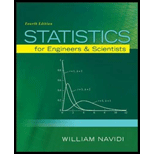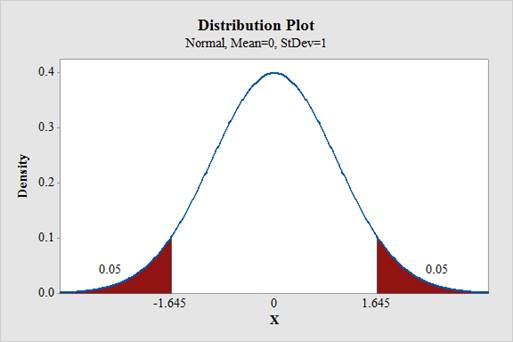
Concept explainers
The following MINITAB output presents the results of a hypothesis test for a population proportion p.
| Test and CI for One Proportion : X | ||||||
| Test of p = 0.4 vs p < 0.4 | ||||||
| Variable X | X 73 | N 240 | Sample p 0.304167 | 95% Upper Bound 0.353013 | Z-Value –3.03 | P-Value 0.001 |
- a. Is this a one-tailed or two-tailed test?
- b. What is the null hypothesis?
- c. Can H0 be rejected at the 2% level? How can you tell?
- d. Someone asks you whether the null hypothesis H0 : p ≥ 0.45 versus H1 : p > 0.45 can be rejected at the 2% level. Can you answer without doing any calculations? How?
- e. Use the output and an appropriate table to compute the P-value for the test of H0 : p ≤ 0.25 versus H1: p > 0.25.
- f. Use the output and an appropriate table to compute a 90% confidence interval for p.
a.
Identify whether the hypotheses test is a one tailed or two tailed test.
Answer to Problem 12E
The test is a one tailed test.
Explanation of Solution
Given info:
The MINITAB output represents the results of a hypothesis test for a population proportion.
Justification:
From the given MINITAB output, the alternative hypothesis represents the less than symbol. Therefore, the form of alternative hypothesis is
b.
Find the null hypothesis.
Explanation of Solution
Justification:
From the MINITAB output, the form of alternative hypothesis is
Thus, the null hypothesis is
c.
Check whether the null hypothesis is rejected at the 2% level or not.
Answer to Problem 12E
Yes, the null hypothesis can be rejected at the 2% level.
Explanation of Solution
Calculation:
From the given MINITAB output, the test statistic is –3.03 and the P-value is 0.001.
Decision rule:
If
If
Conclusion:
Here, the P-value is less than the level of significance 0.02.
That is
Therefore, the null hypothesis is rejected.
d.
Check whether the null hypothesis
Answer to Problem 12E
Yes, the null hypothesis can be rejected at the 2% level.
Explanation of Solution
Calculation:
From the given MINITAB output, the sample proportion is 0.304167.
Thus, the P-value for
e.
Find the P-value for the test of
Answer to Problem 12E
The P-value is 0.026.
Explanation of Solution
Calculation:
Test statistic and P-value:
Software Procedure:
Step-by-step procedure to obtain the z-score using the MINITAB software:
- Choose Stat > Basic Statistics > 1 Proportion.
- Choose Summarized data.
- In Number of events, enter 73. In Number of trials, enter 240.
- Check Perform hypothesis test. In Hypothesized proportion, enter 0.25.
- Click Options. Under Alternative, and choose less than.
- Click OK in each dialog box.
Output using the MINITAB software is given below:

From the MINITAB output, the z-score is 1.94 and the P-value is 0.026.
f.
Find the 90% confidence interval for p.
Answer to Problem 12E
The 90% confidence interval is (0.2588, 0.3560).
Explanation of Solution
Calculation:
The formula for confidence interval is as follows:
Where,
The value of
Critical value:
Software procedure:
Step-by-step procedure to obtain the critical value using the MINITAB software:
- Choose Graph > Probability Distribution Plot choose View Probability > OK.
- From Distribution, choose ‘Normal’ distribution.
- Click the Shaded Area tab.
- Choose Probability Value and Both Tail for the region of the curve to shade.
- Enter the Probability value as 0.10.
- Click OK.
Output using the MINITAB software is given below:

Thus,
The 90% confidence interval is as follows:
Thus, the 90% confidence interval is (0.2588, 0.3560).
Want to see more full solutions like this?
Chapter 6 Solutions
Statistics for Engineers and Scientists
Additional Math Textbook Solutions
APPLIED STAT.IN BUS.+ECONOMICS
University Calculus: Early Transcendentals (4th Edition)
Elementary Statistics: Picturing the World (7th Edition)
University Calculus
Elementary Statistics ( 3rd International Edition ) Isbn:9781260092561
Elementary Algebra For College Students (10th Edition)
- 5. Probability Distributions – Continuous Random Variables A factory machine produces metal rods whose lengths (in cm) follow a continuous uniform distribution on the interval [98, 102]. Questions: a) Define the probability density function (PDF) of the rod length.b) Calculate the probability that a randomly selected rod is shorter than 99 cm.c) Determine the expected value and variance of rod lengths.d) If a sample of 25 rods is selected, what is the probability that their average length is between 99.5 cm and 100.5 cm? Justify your answer using the appropriate distribution.arrow_forward2. Hypothesis Testing - Two Sample Means A nutritionist is investigating the effect of two different diet programs, A and B, on weight loss. Two independent samples of adults were randomly assigned to each diet for 12 weeks. The weight losses (in kg) are normally distributed. Sample A: n = 35, 4.8, s = 1.2 Sample B: n=40, 4.3, 8 = 1.0 Questions: a) State the null and alternative hypotheses to test whether there is a significant difference in mean weight loss between the two diet programs. b) Perform a hypothesis test at the 5% significance level and interpret the result. c) Compute a 95% confidence interval for the difference in means and interpret it. d) Discuss assumptions of this test and explain how violations of these assumptions could impact the results.arrow_forward1. Sampling Distribution and the Central Limit Theorem A company produces batteries with a mean lifetime of 300 hours and a standard deviation of 50 hours. The lifetimes are not normally distributed—they are right-skewed due to some batteries lasting unusually long. Suppose a quality control analyst selects a random sample of 64 batteries from a large production batch. Questions: a) Explain whether the distribution of sample means will be approximately normal. Justify your answer using the Central Limit Theorem. b) Compute the mean and standard deviation of the sampling distribution of the sample mean. c) What is the probability that the sample mean lifetime of the 64 batteries exceeds 310 hours? d) Discuss how the sample size affects the shape and variability of the sampling distribution.arrow_forward
- A biologist is investigating the effect of potential plant hormones by treating 20 stem segments. At the end of the observation period he computes the following length averages: Compound X = 1.18 Compound Y = 1.17 Based on these mean values he concludes that there are no treatment differences. 1) Are you satisfied with his conclusion? Why or why not? 2) If he asked you for help in analyzing these data, what statistical method would you suggest that he use to come to a meaningful conclusion about his data and why? 3) Are there any other questions you would ask him regarding his experiment, data collection, and analysis methods?arrow_forwardBusinessarrow_forwardWhat is the solution and answer to question?arrow_forward
- To: [Boss's Name] From: Nathaniel D Sain Date: 4/5/2025 Subject: Decision Analysis for Business Scenario Introduction to the Business Scenario Our delivery services business has been experiencing steady growth, leading to an increased demand for faster and more efficient deliveries. To meet this demand, we must decide on the best strategy to expand our fleet. The three possible alternatives under consideration are purchasing new delivery vehicles, leasing vehicles, or partnering with third-party drivers. The decision must account for various external factors, including fuel price fluctuations, demand stability, and competition growth, which we categorize as the states of nature. Each alternative presents unique advantages and challenges, and our goal is to select the most viable option using a structured decision-making approach. Alternatives and States of Nature The three alternatives for fleet expansion were chosen based on their cost implications, operational efficiency, and…arrow_forwardBusinessarrow_forwardWhy researchers are interested in describing measures of the center and measures of variation of a data set?arrow_forward
- WHAT IS THE SOLUTION?arrow_forwardThe following ordered data list shows the data speeds for cell phones used by a telephone company at an airport: A. Calculate the Measures of Central Tendency from the ungrouped data list. B. Group the data in an appropriate frequency table. C. Calculate the Measures of Central Tendency using the table in point B. 0.8 1.4 1.8 1.9 3.2 3.6 4.5 4.5 4.6 6.2 6.5 7.7 7.9 9.9 10.2 10.3 10.9 11.1 11.1 11.6 11.8 12.0 13.1 13.5 13.7 14.1 14.2 14.7 15.0 15.1 15.5 15.8 16.0 17.5 18.2 20.2 21.1 21.5 22.2 22.4 23.1 24.5 25.7 28.5 34.6 38.5 43.0 55.6 71.3 77.8arrow_forwardII Consider the following data matrix X: X1 X2 0.5 0.4 0.2 0.5 0.5 0.5 10.3 10 10.1 10.4 10.1 10.5 What will the resulting clusters be when using the k-Means method with k = 2. In your own words, explain why this result is indeed expected, i.e. why this clustering minimises the ESS map.arrow_forward
 Glencoe Algebra 1, Student Edition, 9780079039897...AlgebraISBN:9780079039897Author:CarterPublisher:McGraw Hill
Glencoe Algebra 1, Student Edition, 9780079039897...AlgebraISBN:9780079039897Author:CarterPublisher:McGraw Hill College Algebra (MindTap Course List)AlgebraISBN:9781305652231Author:R. David Gustafson, Jeff HughesPublisher:Cengage Learning
College Algebra (MindTap Course List)AlgebraISBN:9781305652231Author:R. David Gustafson, Jeff HughesPublisher:Cengage Learning


